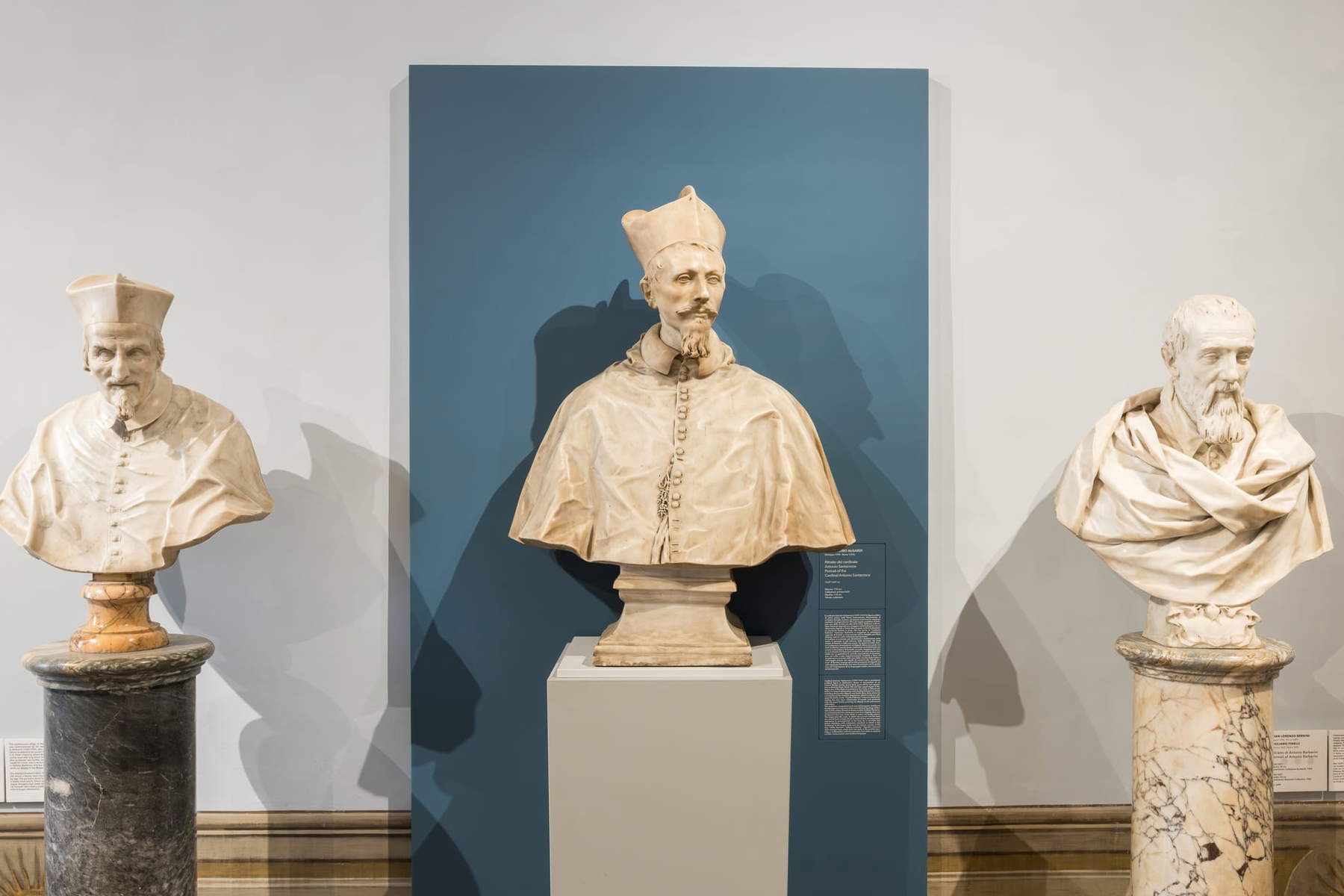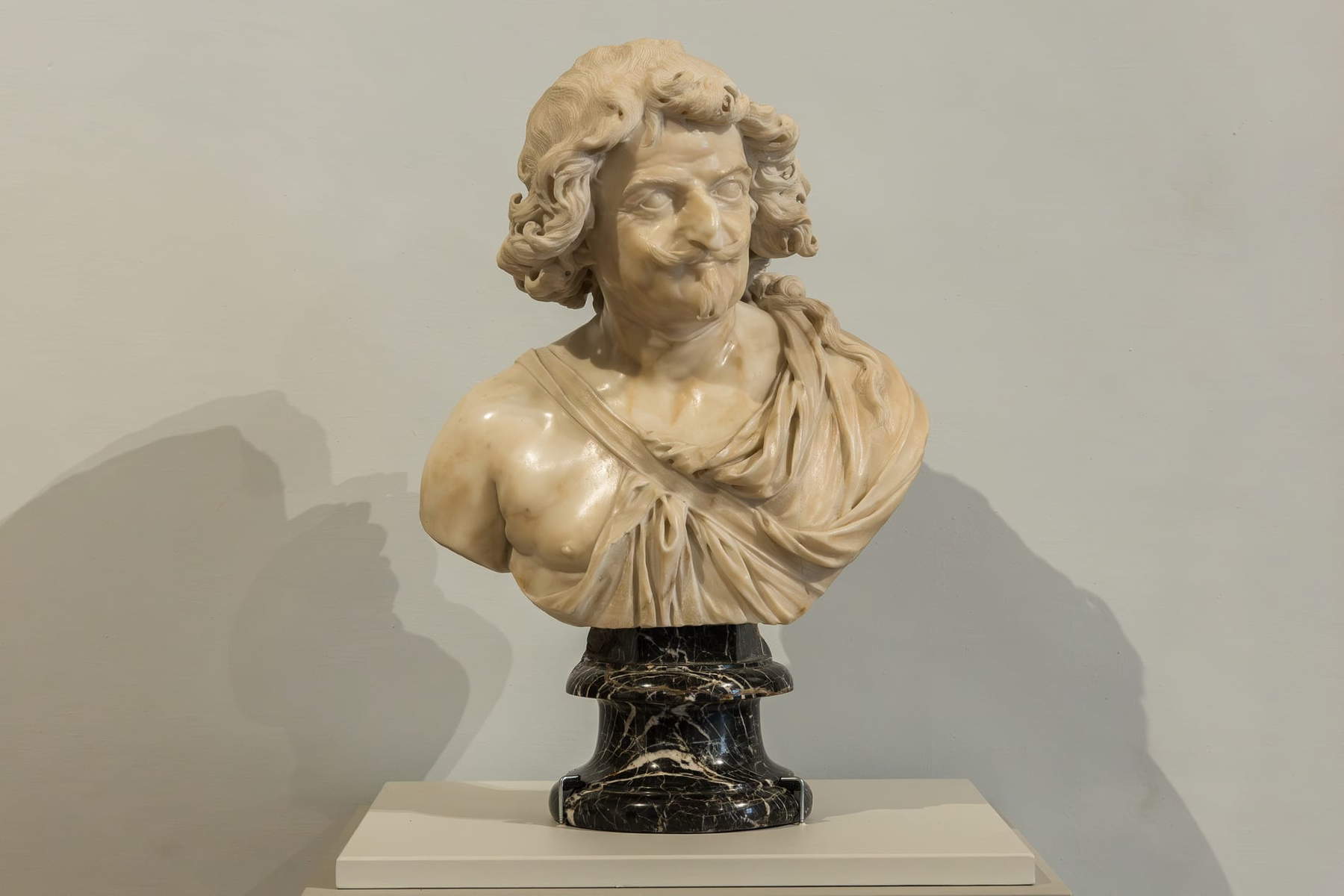Starting Oct. 21, 2025, the National Galleries of Ancient Art in Rome present a new chapter in the enhancement of its collections. Two extraordinary Baroque busts signed by Alessandro Algardi (Bologna, 1595 - Rome, 1654) and François Duquesnoy (Brussels, 1597 - Livorno, 1643) make their entrance in the Sala Sacchi of Palazzo Barberini, the heart of the Roman museum. The two sculptures, which recount the complexity of seventeenth-century Rome from different perspectives, offer valuable insight into the refined artistic culture of the Barberini family and the intellectual climate of the papal capital in the first half of the seventeenth century.
The first of the two busts is a monumental work by Alessandro Algardi, depicting Cardinal Antonio Santacroce. Made around 1639-1641 and coming from a private collection, the sculpture had never been on public display. Entirely carved from a single block of marble, the bust represents one of the highest examples of Baroque portraiture and testifies to the extraordinary technical skill and formal sensitivity of the Bolognese artist. Algardi, who was born in 1598 and moved to Rome in 1625, was one of the protagonists of Baroque classicism and one of the few true rivals of Gian Lorenzo Bernini, with whom he shared an intense season of commissions and stylistic confrontation.
Cardinal Antonio Santacroce, who was born in 1599 and died in 1641, belonged to one of the most influential families in Barberini’s Rome. A prominent politician, refined collector, and leading figure in the papal curia, he was close to Cardinal Francesco Barberini, nephew of Pope Urban VIII, and took an active part in the city’s cultural life. Algardi portrays him in a sober and measured language, far from the theatricality and dramatic tension that characterize Bernini’s portraits. In the sculpture, the cardinal’s face emerges from a compact mass of marble, with a proud, absorbed gaze, restrained features and a composure that communicates authority and introspection. The finely carved beard and hair testify to a meticulous attention to detail, while the overall composition reveals a solemnity that transcends time and returns the image of a man aware of his role, but also of the transience of life.

This bust, probably made to decorate the family palace, is part of that tradition of marble portraits that, in Baroque Rome, constituted not only instruments of personal celebration but also statements of cultural belonging and taste. Algardi’s work, while welcoming some Bernini suggestions in the psychological rendering of the face, asserts an autonomous poetics based on balance and inner intimacy. It is a language that stands as an alternative to the spectacularity of the triumphant Baroque and that, in time, will profoundly influence Roman sculpture of the mid-17th century.
Next to the bust of Cardinal Santacroce, the Sacchi Room houses a second masterpiece: the portrait of the Dwarf of the Duke of Créquy, sculpted by François Duquesnoy. The Flemish artist, born in Brussels in 1597 and active in Rome until his death in 1643, was one of the greatest interpreters of Roman classicism. After collaborating with artists such as Pietro da Cortona and Nicola Poussin, Duquesnoy developed a personal style in which the grace and composure of ancient art were combined with a subtle sense of realism. His approach, profoundly different from that of Bernini and the more dramatic Baroque artists, favored measure and delicacy, anticipating some of the tendencies of neoclassicism.
The bust, from the collections of Palazzo Barberini, depicts Michel Magnan, known as Micheau, a singular character at the French court, known as the dwarf of Duke Charles I de Créquy, ambassador of the French king to Rome. The work, probably conceived as a diplomatic gift for Cardinal Antonio Barberini, combines the rigor of the classical layout with a surprising vividness of expression. Duquesnoy depicts Micheau with a fashionable hairstyle and richly detailed clothing, but he introduces a subtle irony into his face, a barely noticeable smile that humanizes his figure. In this mixture of naturalness and idealization, the portrait goes beyond mere physiognomic description and becomes an exercise in balancing grace and reality.

The Duke of Créquy’s bust of the Dwarf is also notable for its attention to the character’s psychology. Although it is a marginal subject in relation to the social hierarchy of the time, Duquesnoy elevates him to a protagonist, restoring a new dignity to him, inscribed in the formal perfection of the marble. The result is a work of profound modernity, capable of blending irony and respect, observation and idealization. This approach, typical of Duquesnoy’s poetics, reflects a humanistic vision of art, in which beauty is the fruit of an inner measure rather than a spectacular artifice.
The display of the two busts in the Sacchi Room creates an unprecedented dialogue: on the one hand, Algardi represents the solemnity of power and the composure of the official portrait; on the other, Duquesnoy introduces a note of lightness and humanity. Both, however, share a tension toward harmony and balance, which distinguishes them in the panorama of Roman Baroque sculpture. Their presence at Palazzo Barberini is not accidental: the Barberinis were among the leading patrons and collectors of the seventeenth century, promoters of an artistic language that combined splendor and intellectuality. Their collections, which today form the nucleus of the National Galleries of Ancient Art, reflect that same ability to combine pomp and rigor, exuberance and measure.
The dialogue between Algardi and Duquesnoy, reactivated by this exhibition, offers the public an opportunity to reflect on the pluralism of the Roman Baroque, often simplified in Bernini’s hegemony. The two sculptures show how the papal capital was a workshop of different languages, in which the confrontation between Italian and foreign artists produced results of extraordinary richness. In seventeenth-century Rome, the presence of artists such as Duquesnoy contributed to a reflection on the relationship between nature and idealization, pathos and balance, anticipating the debate that would dominate European aesthetics in the following centuries.
 |
| Rome, two baroque masterpieces by Algardi and Duquesnoy at Palazzo Barberini |
Warning: the translation into English of the original Italian article was created using automatic tools. We undertake to review all articles, but we do not guarantee the total absence of inaccuracies in the translation due to the program. You can find the original by clicking on the ITA button. If you find any mistake,please contact us.